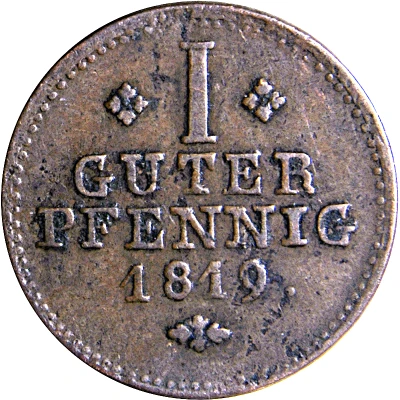


© Ulmo
1 Pfennig - William I
| Copper | 2.3 g | 21 mm |
| Issuer | Electorate of Hesse (Province of Schaumburg-Hessen, Hesse-Cassel) |
|---|---|
| Prince elector | William I (1803-1807, 1813-1821) |
| Type | Standard circulation coin |
| Years | 1816-1821 |
| Value | 1 Pfennig (1⁄288) |
| Currency | Thaler (1803-1840) |
| Composition | Copper |
| Weight | 2.3 g |
| Diameter | 21 mm |
| Shape | Round |
| Technique | Milled |
| Orientation | Medal alignment ↑↑ |
| Demonetized | Yes |
| Updated | 2024-10-05 |
| Numista | N#71085 |
|---|---|
| Rarity index | 76% |
Reverse
4-line inscription with date and denomination, rosette below.
Script: Latin
Lettering: *1* // GUTER // PFENNIG // 1821 //*
Edge
Plain
Comment
The W-K stands for the initials of Wilhelm I., Kurfürst von Hessen who became the Prince-Elector of Hesse in 1803. In 1806 his electorate was annexed by the Kingdom of Westphalia, ruled by Jérôme Bonaparte, Napoleon's brother. William escaped to Denmark with his family and lived there in exile until the French were expelled from Germany. Following the defeat of the Napoleonic armies in the Battle of Leipzig, William was restored in 1813 and ruled until his death in 1821.Interesting fact
One interesting fact about the 1 Pfennig coin from the Electorate of Hesse is that it was minted during a time of great economic and political change in Germany. The coin was issued during the reign of William I, who was the first king of Prussia and played a significant role in the unification of Germany. The coin's design, which features an image of William I on one side and the Hessian coat of arms on the other, reflects the political and cultural ties between the Electorate of Hesse and the Kingdom of Prussia during this time.



